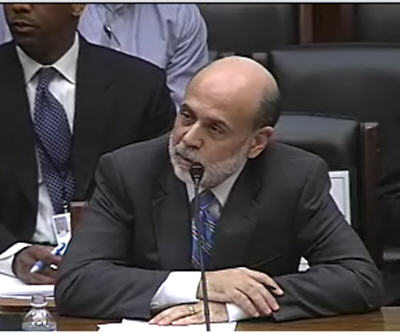The consequences of current global monetary policy will be higher prices for both gold and silver

Finally, we have a break to the upside in both gold and silver, something that many precious metals investors have been patiently waiting for, but expected to happen. The price of gold is now a tad away from breaching the $1700 an ounce level, after smashing through the key resistance levels at $1625 an ounce and $1650 an ounce.
As US Federal Reserve Chairman, Ben Bernanke, began his eagerly awaited speech at the annual symposium at Jackson Hole, Wyoming, the price of gold dropped sharply. After trading above $1660 an ounce last Friday, the price of spot gold suddenly dropped to an intra-day low of $1644 an ounce. Afterwards, the price suddenly reversed direction and surged higher to end the day, the week and the month at $1692.30 per ounce, the highest level since May of this year. The price of gold is now well above its 50 day Moving Average and is building strong support above its 200 day Moving Average currently set at just under $1650 an ounce.
As the price of gold rallied, the yield on the US 10 year bond dropped to 1.562%, down from 1.678% compared with the previous weeks close and August’s high of 1.863%. The yield on the 30 year bond also tumbled to close at 2.684%, also at the week’s low. The euro increased against the greenback for a third week, the longest stretch since March. Last week, the dollar fell 0.5% versus the euro to $1.2579 after losing 1.4% in the five days ended Aug. 24. The yen was little changed at 98.46 per euro. And, the Dollar Index, which tracks the greenback against the currencies of six major U.S. trade partners including the euro and the yen, fell 0.5% to 81.204. Since the beginning of August the dollar has declined by around 3% in value while the price of gold posted a 4.5% gain in August, its third straight monthly rise and its biggest since January.
The symposium which has been sponsored by the Federal Reserve Bank of Kansas City since 1978 focuses on important economic issues that face the U.S. and world economies. Participants include prominent central bankers and finance ministers, as well as academic luminaries and leading financial market players from around the world.
The Symposium proceedings are closely followed by market participants, as unexpected remarks emanating from any of the major speakers at the Symposium can impact on global equities and commodities, as well as the financial and currency markets.
In his speech, Bernanke was adamant that his current monetary policies have proven to be successful.
“The accommodative monetary policies I have reviewed today, both traditional and non-traditional, have provided important support to the economic recovery while helping to maintain price stability. As of July, the unemployment rate had fallen to 8.3% from its cyclical peak of 10% and payrolls had risen by 4 million jobs from their low point.”
Frankly, I am not sure what Bernanke meant when he spoke about price stability. While prices are affected by natural as well as man-made forces such as droughts, floods, war and political turmoil, expansionary monetary policies and market intervention, causes additional price and market dislocations.
In a statement released by the World Bank, global food prices jumped 10% in July. From June to July, corn and wheat prices increased by 25% each, soybean prices by 17%, and only rice prices went down, by 4%, the World Bank said on Thursday.
The World Bank’s Food Price Index, which tracks the price of internationally traded food commodities, was 6% higher compared to July of last year, and 1% over the previous peak of February 2011.
U.S. soybean futures hit a record high of $17.78 per bushel in trading last Thursday, while corn futures remained near the record of $8.49 set earlier in August.
While it is not possible to mathematically identify what percentage of price increases is due to monetary easing, speculation or drought, the fact remains that prices are not stable. And, these higher prices in basic foodstuffs can have a devastating impact for people who rely on a fixed income from savings and pensions. Furthermore, the impact on these higher prices will only be felt in months to come.
With regard to unemployment, I do not believe the government reports as I am sure that they are slightly skewered and probably, the true figure is much higher than the reported 8.3%.
Nevertheless, Bernanke admitted that the situation regarding the US economy has not been satisfactory.
“Notwithstanding these positive signs, the economic situation is obviously far from satisfactory. The unemployment rate remains more than 2 percentage points above what most FOMC participants see as its longer-run normal value, and other indicators–such as the labour force participation rate and the number of people working part time for economic reasons–confirm that labour force utilization remains at very low levels. Further, the rate of improvement in the labour market has been painfully slow.’
He went on to say that slow recovery in the US could be attributed to the housing sector, fiscal policy and stresses in credit and financial markets. On fiscal policy he said that “both the federal and state and local levels, has become an important headwind for the pace of economic growth.” He also mentioned that the problems in the Eurozone were also a major concern.
“More recently, however, a major source of financial strains has been uncertainty about developments in Europe. These strains are most problematic for the Europeans, of course, but through global trade and financial linkages, the effects of the European situation on the U.S. economy are significant as well”
In closing Bernanke said. “Over the past five years, the Federal Reserve has acted to support economic growth and foster job creation, and it is important to achieve further progress, particularly in the labour market. Taking due account of the uncertainties and limits of its policy tools, the Federal Reserve will provide additional policy accommodation as needed to promote a stronger economic recovery and sustained improvement in labour market conditions in a context of price stability.”
While Bernanke did not discuss any specific policy action the US Fed was contemplating nor did he hint at the timing of when more monetary policy easing could be delivered he seemed to provide enough clues that further stimulus is imminent.
It looks as if September is going to be an exciting month for gold. Firstly, on the back of Bernanke’s speech, this Friday’s August payroll report will be extremely important. It seems that the markets are expecting the US job market to increase by around 125,000 and it is believed that any number below 100,000 will greatly increase the chances of the Fed easing in the FOMC meeting on September 13.
In the meantime, according to the central bank of Spain, $70.90 billion left Spanish banks during the month of June which was close to a 40% rise in capital outflow. And, in July it was worse at $92.88 billion. That represents 4.7% of the deposit base gone in 30 days! For the first seven months of the year the outflows add up to $368.80 billion or 17.7% of the total bank deposits of Spain. It looks as if the financial situation in Spain is dire and getting worse by the day and that Spain is experiencing a full-fledged run on its banks.
Another issue that has been totally overlooked is the situation in Japan. Evidentally, Japan’s government is planning to suspend some state spending as it could run out of cash by October. Apparently, the problem is due to Japanese politicians who have blocked a deficit financing bill. According to Reuters, the impasse in Japan’s parliament has raised fears among investors that the world’s third largest economy is being driven towards a “fiscal cliff,” “The government running out of money is not a story made up. It’s a real threat,” Finance Minister Jun Azumi told a news conference, making a last-ditch appeal for cooperation by opposition parties to pass the bill.
“Failing to pass the bill will give markets the impression that Japan’s fiscal management rests on shaky ground,” he said.
Unless the bill clears the current parliamentary session that ends next week, the government will start suspending or reducing some state spending to avoid running out of money for as long as possible, the finance ministry said.
Noda’s ruling Democratic Party passed the deficit-financing bill through the lower house on Tuesday. But the opposition boycotted the vote, signalling the bill has little chance of clearing the opposition-controlled upper house.
The dire economic situation that persists globally seems to only get worse. And, the financial system looks increasingly precarious. If history is to repeat itself once again, we will see financial chaos as politicians and financial leaders around the world drive us over the cliff of financial and monetary disaster.
If you have not yet added gold and silver to your investment portfolio, how much longer are you going to remain on the side-lines? It is time to act now and accumulate a core holding of physical gold and silver.
It is evident that the bottom of the last correction was posted during May, and the upward trend in gold has now resumed. I expect the current up-leg that began end July to meet some resistance between $1700/oz and $1725/oz before it moves higher to test $1800/oz.
By David Levenstein
About the author
David Levenstein is a leading expert on investing in precious metals . Although he began trading silver through the LME in 1980, over the years he has dealt with gold, silver, platinum and palladium. He has traded and invested in bullion, bullion coins, mining shares, exchange traded funds, as well as futures for his personal account as well as for clients.
Information contained herein has been obtained from sources believed to be reliable, but there is no guarantee as to completeness or accuracy. Any opinions expressed herein are statements of our judgment as of this date and are subject to change without notice.
More News
{{ commodity.name }}
{{ post.title }}
{{ post.date }}


Comments